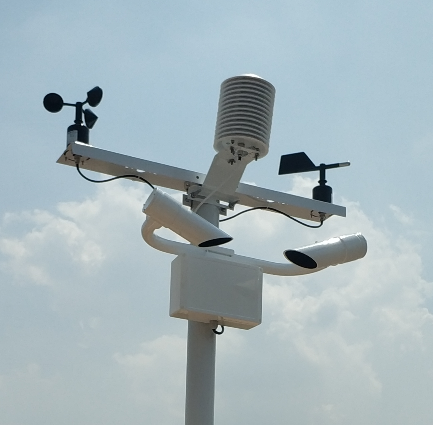The business of mining—extracting valuable resources from deep within the earth—is paradoxically vulnerable to the weather above. Unpredictable shifts in wind, rainfall, and temperature are not just atmospheric events; they are critical variables that directly govern mine safety, production efficiency, and financial viability.
In today’s operational landscape, high-precision meteorological monitoring is no longer a niche tool. It is now recognized as The Underground Shield—the primary defense guaranteeing safe, compliant operations—and The Sky's Eye—the intelligent sensor driving sustainable, high-efficiency mining practices.
Safety is non-negotiable in mining. Meteorological hazards are arguably the most unpredictable and destructive threats to continuous operations.
Open-pit mines are essentially large basins where heavy rainfall accumulates rapidly. Beyond submerging critical equipment and halting production, severe rain can quickly compromise slope stability, triggering devastating landslides and debris flows.
To counter this, CODA's Tipping Bucket Rainfall Gauge (CDY-12A) provides highly reliable, real-time precipitation data. This allows operational teams to instantly predict flash flood risks and secure the invaluable "golden window" needed for emergency personnel evacuation and timely equipment relocation.
Mines often feature vast, exposed operational areas where large machinery, tall structures, and explosive caches become natural lightning rods. A sophisticated warning system, fed by real-time atmospheric data, can track thundercloud formation and movement, triggering immediate alerts to halt high-risk, high-altitude work.
For operations involving cranes and conveyors, high winds present a constant risk of structural failure. CODA's rugged Wind Speed Sensor (CDF-10A)—built with carbon fiber for a low starting threshold and high corrosion resistance—ensures continuous, accurate measurement. This data enables automatic shutdown of hoisting operations when wind speeds approach critical thresholds. Furthermore, data from CODA Automatic Weather Stations (AWS) is essential for managing visibility (fog) and friction (ice), providing direct evidence to support safe transport scheduling and road treatment decisions.
Beyond mitigating immediate risks, meteorological data is fundamentally interwoven into the production workflow, acting as the key to maximizing output and minimizing waste.
Blasting is central to extraction. Wind speed and direction are the sole factors determining where dust and noxious gases will disperse post-blast. By integrating specialized micrometeorological data—often from high-accuracy CODA Ultrasonic Anemometers (CDF-21A/22A)—mine managers can select the precise "environmental window" for each explosion, thereby upholding strict safety protocols and environmental mandates simultaneously.
Dust generation is a major environmental and health concern at mine sites. Dry, windy conditions exacerbate dispersion. By continually monitoring localized humidity, wind speed, and wind direction, a CODA AWS allows for the intelligent activation of water sprinkling systems. This precision ensures water is deployed only at the optimal time and location, achieving superior dust suppression with minimal water consumption.
Tailings Storage Facilities (TSFs) demand rigorous structural oversight. Their stability is critically dependent on moisture balance. Deploying CODA Tipping Bucket Gauges (CDY-12A) around TSFs enables operators to calculate exact water ingress and evaporation rates. This real-time data is indispensable for continuous dam stability modeling and proactive prevention of disastrous breaches.
Long-term meteorological analysis facilitates superior operational planning. This might involve fast-tracking excavation in low-lying areas ahead of the rainy season or precisely timing equipment maintenance to avoid non-productive downtime caused by unforeseen weather. Accurate, continuous data from CODA sensors safeguards assets and prevents financial loss from unexpected shutdowns.
With increasingly stringent environmental regulations, mines must meticulously track and report environmental impacts (e.g., air and water quality). Meteorological data provides crucial contextual evidence—for example, proving that a temporary surge in dust readings was due to an anomalous natural wind event rather than a lapse in operational management. This data is the bedrock of transparent, compliant operation.
The frequency of extreme weather events is escalating globally. By maintaining comprehensive, multi-year meteorological data sets, mines can accurately assess and quantify the long-term risks posed by climate change—such as shifting rainfall patterns or prolonged heatwaves. This foresight enables planners to make future-proof decisions on infrastructure design and long-term extraction strategy.

In the competitive modern mining sector, the investment in a reliable, advanced meteorological monitoring system, featuring solutions like those provided by CODA, is no longer merely a defensive measure. It is a strategic imperative. The monitoring station functions as the digital command center, connecting atmospheric realities to subterranean operations. For any enterprise committed to a future that is safe, efficient, and sustainable, reading the code of the sky is the only way to responsibly harness the treasures of the earth.
Discover how real-time weather station data impr
Discover how Automatic Weather Stations (AWS) ar
Discover how CODA gas sensors are the invisible
Contact: Molly
Phone: +86-17775769236
Tel: 86-0731-85117089
Email: molly@codasensor.com
Add: Building S5, Aux Square, Yuelu District, Changsha City, Hunan Province, China
We chat